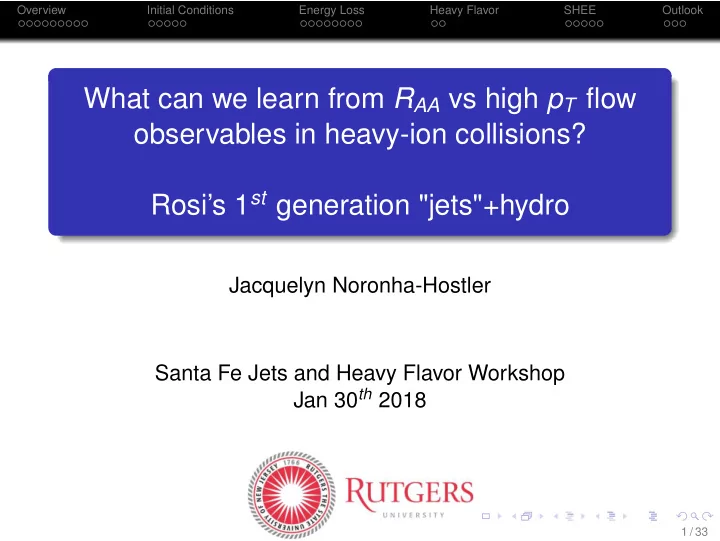

Overview Initial Conditions Energy Loss Heavy Flavor SHEE Outlook What can we learn from R AA vs high p T flow observables in heavy-ion collisions? Rosi’s 1 st generation "jets"+hydro Jacquelyn Noronha-Hostler Santa Fe Jets and Heavy Flavor Workshop Jan 30 th 2018 1 / 33
Overview Initial Conditions Energy Loss Heavy Flavor SHEE Outlook Modeling of Heavy-Ion Collisions Hydrodynamics Initial Conditions Pressure, Quantum fluctuations in energy, entropy (for heavy-ions collisions) the position of in a nutshell nucleons/QCD fields Hydrodynamics viscosity and thermodynamics Hadron Gas: number of hadrons,decays, Hard Probes interactions etc Produced early, lose energy in medium Hydrodynamics τ 0 initial time to switch on hydro Tsw temperature at which the Quark Gluon Plasma switches to hadrons 2 / 33
Overview Initial Conditions Energy Loss Heavy Flavor SHEE Outlook Event-by-Event Initial Conditions Quantum Mechanical Fluctuations circa 2010 3 / 33
Overview Initial Conditions Energy Loss Heavy Flavor SHEE Outlook Perfect fluidity leads to elliptical flow Impact region of two heavy ions Initial Condition (not really spheres due to quantum fluctuations) Final State 4 / 33
Overview Initial Conditions Energy Loss Heavy Flavor SHEE Outlook Perfect fluidity leads to elliptical flow Shape quantified by eccentricities ε n where n=2 Initial Condition (ellipse), n=3 (triangle), n=4 (square) ... Pressure gradients push outwards Final State V n α ε n 5 / 33
Overview Initial Conditions Energy Loss Heavy Flavor SHEE Outlook Azimuthal anisotropies The distribution of particles can be written as a Fourier series � � E d 3 N d 2 N d 3 p = 1 � 1 + 2 v n cos [ n ( φ − ψ n )] 2 π p T dp T dy n Flow Harmonics at mid-rapidity � 2 π dN d φ p T dp T d φ cos [ n ( φ − Ψ n )] 0 v n ( p T ) = � 2 π dN d φ 0 p T dp T d φ n arctan � sin [( n φ )] � where Ψ n = 1 � cos [( n φ )] � 6 / 33
Overview Initial Conditions Energy Loss Heavy Flavor SHEE Outlook High p T flow harmonics Correlate 1 high p T particle More high p T particles are with 1(+) soft particles emitted aligned with the event plane High p T particles sensitive to the path length (initial state) First suggested in early 2000’s Xin-Nian Wang Phys.Rev. C63 (2001) 054902 ; Gyulassy, Vitev, Wang Phys.Rev.Lett. 86 (2001) 2537-2540 7 / 33
Overview Initial Conditions Energy Loss Heavy Flavor SHEE Outlook Learn from soft to understand hard physics Hydrodynamics v 2 {2} ??? Hydrodynamics +energy loss Intermediate p T 8 / 33
Overview Initial Conditions Energy Loss Heavy Flavor SHEE Outlook What properties do we want to learn? Initial Conditions Energy Loss Identified Particles (mass differences) Viscosity Hadronization Critial Point Chiral Magnetic Effect Vorticity How do we disentangle them? 9 / 33
Overview Initial Conditions Energy Loss Heavy Flavor SHEE Outlook Life is complicated- guidance from the soft sector Initial Conditions v-USPhydro+BBMG mckln glauber [Duke] Bernhard et al, Phys. Rev. C 91, 054910 (2015) JNH et al, Phys.Rev.Lett. 116 (2016) no.25, 252301 JNH et al, Phys.Rev. C95 (2017) no.4, Viscosity 044901 Energy Loss 10 / 33
Recommend
More recommend